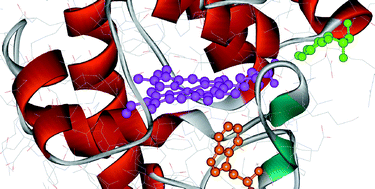QM/MM studies of the electronic structure of the compound I intermediate in cytochrome c peroxidase and ascorbate peroxidase†
Abstract
Cytochrome c peroxidase (CcP) and ascorbate peroxidase (APX) both involve reactive haem oxoferryl intermediates known as ‘compound I’ species. These two enzymes also have a very similar structure, especially in the vicinity of the haem group. Despite this similarity, the electronic structure of compound I in the two enzymes is known to be very different. Compound I intermediates have three unpaired electrons, two of which are always situated on the Fe–O core, whilst the third is located in a porphyrin orbital in APX and many other compound I species. In CcP, however, this third unpaired electron is positioned on a tryptophan residue lying close to the haem ring. The same residue is present in the same position in APX, yet it is not oxidized in that case. We report QM/MM calculations, using accurate B3LYP density functional theory for the QM region, on the active intermediate for both enzymes. We reproduce the observed difference in electronic structure, and show that it arises as a result of subtle electrostatic effects which affect the ionization potential of both the tryptophan and porphyrin groups. The computed structures of both enzymes do not involve deprotonation of the tryptophan group, or protonation of the oxoferryl oxygen.


 Please wait while we load your content...
Please wait while we load your content...